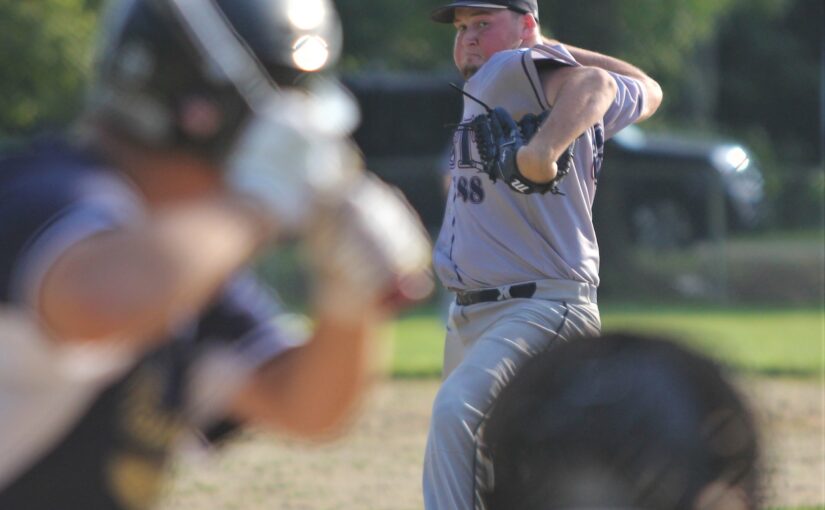Baseball: Turning your ‘throwers’ into pitchers

Finding kids with live arms usually poses a problem. At every level from the Little League to the big leagues, you can find young pitchers with the ability to do it, depending greatly on how they are coached.
Many pitchers try to get by on velocity alone, hoping to overmatch their opponents. For the pitchers possessing A+ fastballs, that may be enough. But, what happens when reaching back and “chuckin’ it” as hard as you can doesn’t work anymore?That leaves two options: Become a full-time position player, or learn how to pitch.
Hopefully, your players will choose the latter and go on to work hard and be receptive to making changes.
Keep it simple
Countless books and videos have been produced on pitching, but the complexities can be too much for some kids. In changing or rebuilding a pitcher’s delivery, it’s best to start with the basics of the belief that consistency is the foundation of all success. A consistent, mechanically sound delivery is the only way to achieve a higher percentage of quality pitches over the season.
Pitchers with random/inconsistent mechanics usually have to “be on” to have their best stuff, making them streaky and unreliable. From the first day of tryouts, you can help your pitchers find a proper delivery and then challenge them to repeat it with every pitch through their muscle and mental memories.
Prepare them mentally
Prepare for the challenges of change by building a strong rapport and trusting your pitchers. Realize that people naturally rebel against change. It doesn’t feel good. It’s hard and frustrating.
Players who have had any success “doing it their way” may resist trying new things. It will feel wrong and the early results may be ugly.
Don’t let this slow you down.
Reassurance on the big picture will make you a better pitcher in the long run. Small steps forward every day will add up quickly over the first few weeks.
Starting the process
First, assess the pitchers’ mechanics and delivery to determine what they do well, and then make a plan to combine their positive attributes with the changes/improvements to come.
What you are doing is creating an environment in which the pitchers can be more receptive and more likely to incorporate the changes. We’re not trying to break them down or recreate their pitching style, but to simply help them acquire new tools and skills.
It’s best to focus on no more than three changes at a time-deliberately forming a good habit before adding another. The integration of good habits will bring each pitcher closer to his goals of consistently improving the staff overall.
To turn our throwers into pitchers we coach them on the six components of what we call Pitching 01: balance, 80/20, stand tall, stay straight, good glove, and finish. Pitching 101 represents the fundamental basics of throwing a pitch by creating a foundation of some mechanics.
Balance
Stay balanced and stay effective. Pitching off-balance produces inconsistent deliveries and release points.
Many pitchers who struggle to stay balanced tend to lose both momentum and accuracy, making it impossible to consistently hit their spots with quality pitches. Consistency is impossible without a balanced delivery.
80/20
As in hitting, pitchers must have their weight back in anticipation of driving toward the plate. This provides many positives:
With their weight over the back hip, pitchers are “loaded up” in a position of strength prior to delivery.
The stride foot can be raised from the ground without “rocking back” which tips the baserunners.
Our pick-off moves are improved by making them quicker (again, no rocking).
Stand tall
In staying balanced with their weight back, pitchers can stand tall in a position of power.
This is vital in driving to the plate with maximum force and keeping the back straight and shoulders level with the ground through the release point.
Don’t allow your pitchers to “tip” a shoulder, making one higher than the other, as they will lose momentum.
Coming to the set position in a crouch or bent at the waist forces a pitcher to raise his torso at the start of his delivery. Rising is negative for two main reasons: to deliver to the plate and to tip baserunners.
Stay straight
As pitchers drive toward the plate, it’s important for the stride leg to land in a straight line between the pivot foot and the target.
Staying straight helps the pitcher to deliver the pitch in a position of power and to finish properly. Landing the stride foot out of line either left or right will place unnecessary stress on the elbow and shoulder, and cause the loss of momentum and force behind the pitch.
Encourage your pitchers to stay straight and level, keeping their hand “behind the ball” as they drive toward the plate.
Good glove
Most pitchers have not been taught how to incorporate their glove arm into their delivery, as all of their focus is on their throwing arm and the pitch itself, with little concern over what the glove arm is doing.
As the stride leg drops from its highest point, the hands separate and the glove reaches out and slightly down at the target.
As the throwing arm comes around to deliver the pitch, the glove should turn palm up; fingers clenched, and are pulled directly into the armpit.
Putting the glove away properly is the first step in developing a consistent finish.
Finish

A delivery that contains balance, power, standing tall, staying straight, good glove, and the ability to execute consistently will produce a soft landing with the stride foot and a dependable finish.
After releasing the ball and completely finishing, the pitcher should “snap to” with his feet shoulder width apart and both hands in front of him at chest level.
The pitcher is now ready to defend himself, become the fifth infielder, and help his team win by defending the middle.
Becoming proficient in the components of Pitching 101 is the huge first step in becoming a consistently competitive pitcher. The next step is developing it through our bullpen sessions.
The process
Your ability to incorporate all of these qualities can be improved through a structured bullpen environment. We start every bullpen session in both practices and games by adhering to five parameters that will enable both the coach and the pitcher to keep it simple and concentrate more of their energy and focus on the tasks at hand.
A disciplined bullpen environment is required to help your pitchers depend on the process and eliminate most distractions.
Bullpen sessions
1. Start from the stretch. It’s important for the components of Pitching 101 to ensure consistency in both the stretch and wind-up. Once the ability to throw all pitches effectively from the stretch is demonstrated, the advancement of the windup will be a natural progression. The analogy that we often use is that the stretch is crawling while the windup is walking.
2. Fastballs only (4 & 2 seam). Every pitchers arsenal must be built around a solid fastball, but when making adjustments to the delivery, the pitchers may fly everywhere at first. The building of consistency will only happen one pitch at a time.
It’s important to deliver a quality fastball on both corners before moving on to another pitch. Unless you are building a specialty pitcher/short reliever with one dominant pitch, your pitchers will only get by for short periods without an effective fastball that they can locate.
3. Corners only. When many pitchers are asked “What’s your target?” they will often answer with a blank stare or guess the mitt or the entire strike zone. The hitters, in comparison, are taught to form the habit to look for a pitch over the middle of the plate that they can drive. So why throw it there? It will be to the pitcher’s advantage to learn how to throw quality pitchers in quality locations that are to the pitcher’s advantage.
Have your catcher set up so that the corner working is in the middle of his chest. Condition your pitchers to work both sides of the plate and to compete on every pitch, regardless of the count.
Pitchers who are able to hit their spots can fight back when behind in the count, and won’t be dependant on grooving a batting practice fastball down the middle. Force them to stay sharp and never give in.
4. 5-5-5. Throwing a pitch in the same spot once or twice is a good start, but throwing it 5x develops a habit. In their bullpen sessions have your pitchers throw to each corner 5 times before changing.
Measure their success by charting how many times out of five pitches can they hit their spot.
It’s important for their mental and muscle memories to learn what a pitch “on the black” feels like so that they can repeat it. At the start, set a goal of 3 out of 5 and quickly move up to 4 out of 5 for a great measurable goal.
5. Simulated innings (5 warm-ups, 15 live pitches). 15 pitches or less in an inning is considered good; the routine expectation both mentally and physically during their bullpen sessions.
Be dedicated to the five warm-up pitches, as this will help with stamina and larger pitch counts later in the season.
Create a game-day goal within your staff to get out of every inning with no more than 15 pitches.
Pitchers have many stats to refer to, but numbers 4 and 5 above provide measurable goals that can be used to chart progress. We refer to these numbers often in practices and games to critique performances.
We will also use our bullpen sessions for more than just throwing a set number of pitchers or a process to build arm strength. As a structured exercise, it will produce immediate feedback and accelerate the areas in which the pitcher can improve.
A combination of Pitching 101 and the discipline and habits formed in the bullpen sessions will create an effective pitcher. Building a fundamentally sound staff in a disciplined and structured pitching program will prepare your team for many successful seasons.



